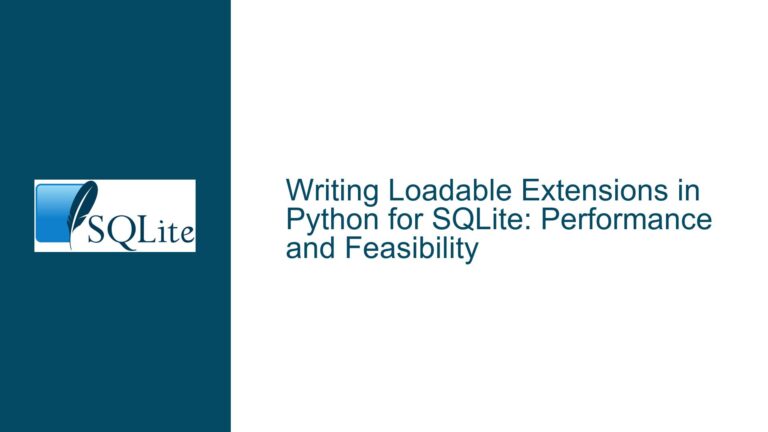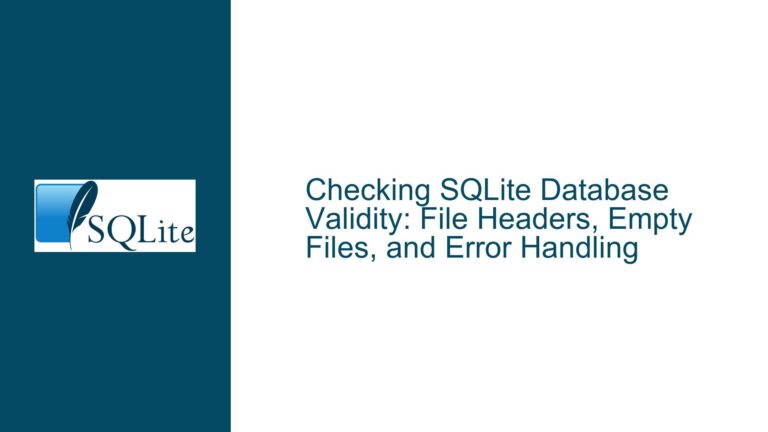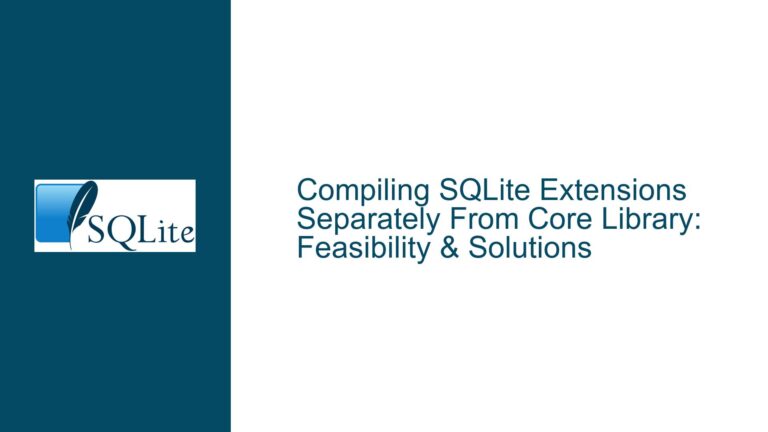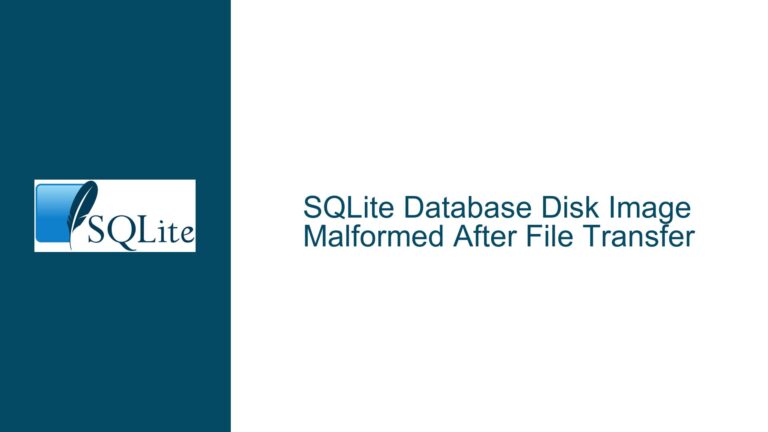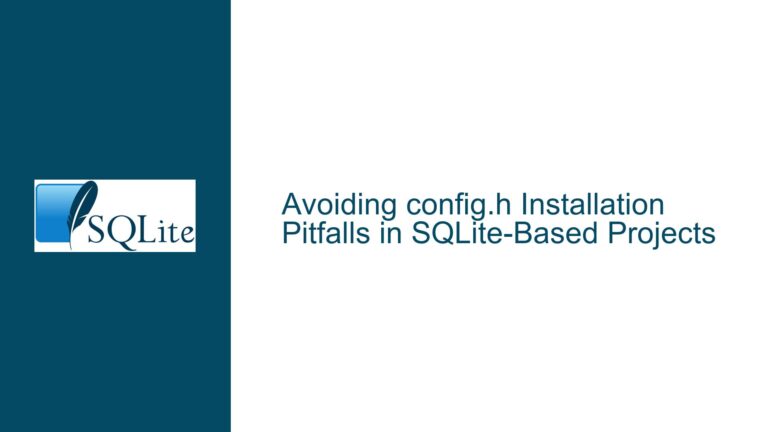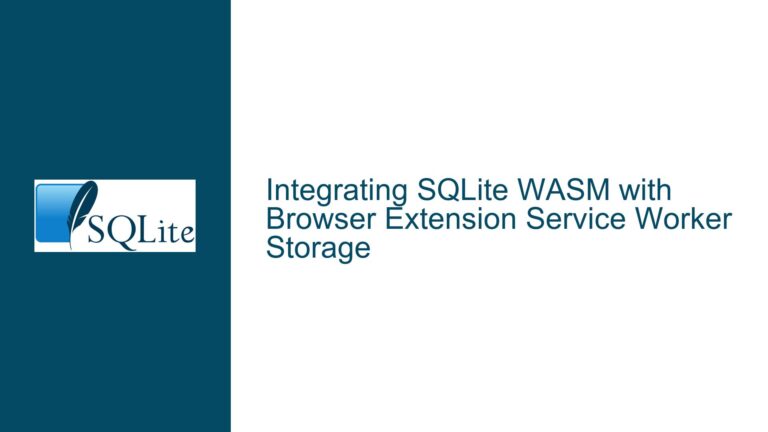Attaching Appended Database Fails Due to VFS Configuration Issues
Understanding Append VFS Integration and ATTACH Failures
The core issue revolves around using SQLite’s append VFS (Virtual File System) to attach a database appended to an executable file. When attempting to use ATTACH DATABASE with the apndvfs VFS via URI syntax, users encounter errors such as "no such vFS: apndvfs" or "file is not a database". These errors stem from misconfiguration in how the append VFS is compiled, registered, or invoked.
The append VFS enables databases to be appended to other files (e.g., executables) while allowing read/write operations to occur in a separate "journal" file. This is useful for distributing self-contained applications with embedded databases. However, its integration requires explicit steps:
- Compilation: The append VFS must be statically compiled into the application or dynamically loaded.
- Registration: The VFS must be registered with SQLite before opening databases that use it.
- URI Syntax: Correct URI parameters must specify the VFS and handle offsets for appended content.
Failures occur when any of these steps are incomplete. For example, the apndvfs VFS is not included in standard SQLite builds, so applications relying on it must explicitly incorporate its source code. Similarly, URI syntax errors (e.g., missing vfs=apndvfs or incorrect offset handling) prevent proper database attachment.
Common Pitfalls in Append VFS Configuration and Usage
1. Missing Append VFS Compilation
The append VFS is implemented in appendvfs.c, which is not part of the SQLite amalgamation by default. If this source file is not compiled and linked into the application, SQLite will lack awareness of the apndvfs VFS. This results in errors like "no such vfs: apndvfs".
2. Improper VFS Registration
Even if appendvfs.c is compiled, the VFS must be registered before use. This involves calling sqlite3_appendvfs_init() or sqlite3_vfs_register() during application initialization. Failing to register the VFS means SQLite cannot route file operations through it.
3. Incorrect URI or Filename Syntax
The URI format for accessing appended databases requires precise parameters:
file://<executable_path>?vfs=apndvfs- Handling the offset where the database is appended within the executable.
Omitting vfs=apndvfs or misformatting the URI (e.g., missing URL encoding for spaces) leads to SQLite using the default VFS, which cannot handle appended databases.
4. Static Linking Macro Omissions
When statically linking the append VFS, developers must define SQLITE_CORE to indicate that the extension is built into the application. Additionally, the SQLITE_EXTENSION_INIT1 and SQLITE_EXTENSION_INIT2 macros must be used to initialize the extension’s interface pointers. Neglecting these steps causes segmentation faults or unresolved symbol errors.
5. File Offset Mismanagement
The append VFS relies on detecting the appended database’s offset within the host file. If the application fails to calculate or specify this offset correctly, SQLite may interpret the executable’s binary code as a corrupted database, yielding "file is not a database" errors.
Resolving Append VFS Registration and Database Attachment Issues
Step 1: Ensure Append VFS Source Inclusion
Action: Verify that appendvfs.c is compiled and linked into your project.
- CMake Example:
add_executable(my_app main.c sqlite3.c appendvfs.c) - Manual Compilation:
gcc -o my_app main.c sqlite3.c appendvfs.c -lpthread -ldl
Verification: Check if the apndvfs VFS is available by querying sqlite3_vfs_list():
sqlite3_vfs *vfs;
for(vfs = sqlite3_vfs_find(0); vfs; vfs = vfs->pNext) {
printf("VFS Name: %s\n", vfs->zName);
}
Step 2: Register the Append VFS During Initialization
Action: Explicitly register the append VFS before opening databases.
#include "sqlite3.h"
#include "appendvfs.c" // Ensure symbols are visible
int main() {
sqlite3_initialize();
sqlite3_auto_extension((void(*)(void))sqlite3_appendvfs_init);
// Alternatively, call sqlite3_appendvfs_init() directly
sqlite3 *db;
sqlite3_open(":memory:", &db);
// ... rest of the code ...
}
Critical Notes:
- Static Linking: Define
SQLITE_COREbefore including SQLite headers to prevent symbol conflicts.#define SQLITE_CORE 1 #include "sqlite3.h" - Macro Initialization: If manually initializing, use:
SQLITE_EXTENSION_INIT1 sqlite3_appendvfs_init(db, NULL, NULL);
Step 3: Use Correct URI Syntax for ATTACH
Action: Construct URIs with vfs=apndvfs and handle offsets.
char *executable_path = "/path/to/executable";
char query[512];
sprintf(query, "ATTACH 'file://%s?vfs=apndvfs' AS appended_db;", executable_path);
sqlite3_exec(db, query, NULL, NULL, &errmsg);
Offset Handling: If the database is appended at a specific offset, include it in the URI:
sprintf(query, "ATTACH 'file://%s?offset=1234&vfs=apndvfs' AS appended_db;", executable_path);
Step 4: Debug Segmentation Faults
Cause: Segfaults often arise from uninitialized sqlite3_api pointers when statically linking.
Fix: Use SQLITE_EXTENSION_INIT1 and SQLITE_EXTENSION_INIT2 macros.
#define SQLITE_CORE
#include "sqlite3.h"
SQLITE_EXTENSION_INIT1
int sqlite3_appendvfs_init(
sqlite3 *db,
char **pzErrMsg,
const sqlite3_api_routines *pApi
) {
SQLITE_EXTENSION_INIT2(pApi);
return sqlite3_vfs_register(sqlite3_appendvfs(), 1);
}
Step 5: Validate Database Integrity
Action: Confirm the appended database is valid.
# Use SQLite CLI to test
./sqlite3 :memory: \
"ATTACH 'file:///path/to/executable?vfs=apndvfs' AS appended_db; \
SELECT * FROM appended_db.sqlite_master;"
Common Fixes:
- Rebuild the Appended Database: Use
sqlite3 original.db ".backup appended.db"and append the new file. - Check File Permissions: Ensure the executable has read/write permissions for the journal file.
Step 6: Cross-Check with SQLite Shell Code
Action: Study SQLite’s shell.c for reference implementations.
- VFS Registration: shell.c registers the append VFS here.
- URI Handling: Note how offsets and VFS parameters are embedded in filenames.
Final Code Example
#define SQLITE_CORE 1
#include "sqlite3.h"
#include "appendvfs.c"
int main() {
sqlite3 *db;
char *errmsg = NULL;
// Initialize append VFS
sqlite3_initialize();
sqlite3_auto_extension((void(*)(void))sqlite3_appendvfs_init);
// Open primary database
if (sqlite3_open("main.db", &db) != SQLITE_OK) {
fprintf(stderr, "Error: %s\n", sqlite3_errmsg(db));
return 1;
}
// Attach appended database
const char *executable_path = "/path/to/executable";
char query[512];
snprintf(query, sizeof(query),
"ATTACH 'file://%s?vfs=apndvfs' AS appended_db;",
executable_path);
if (sqlite3_exec(db, query, NULL, NULL, &errmsg) != SQLITE_OK) {
fprintf(stderr, "ATTACH failed: %s\n", errmsg);
sqlite3_free(errmsg);
return 1;
}
// Query appended database
const char *select_query = "SELECT * FROM appended_db.wf_instances;";
if (sqlite3_exec(db, select_query, NULL, NULL, &errmsg) != SQLITE_OK) {
fprintf(stderr, "Query failed: %s\n", errmsg);
sqlite3_free(errmsg);
return 1;
}
sqlite3_close(db);
return 0;
}
By methodically addressing compilation, registration, URI syntax, and initialization, developers can resolve issues with attaching appended databases using the apndvfs VFS.

